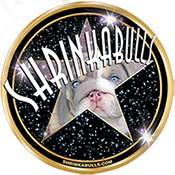

SHRINKABULLS STYLE ENGLISH & FRENCH BULLDOGS





|
RARE ENGLISH BULLDOG COLORS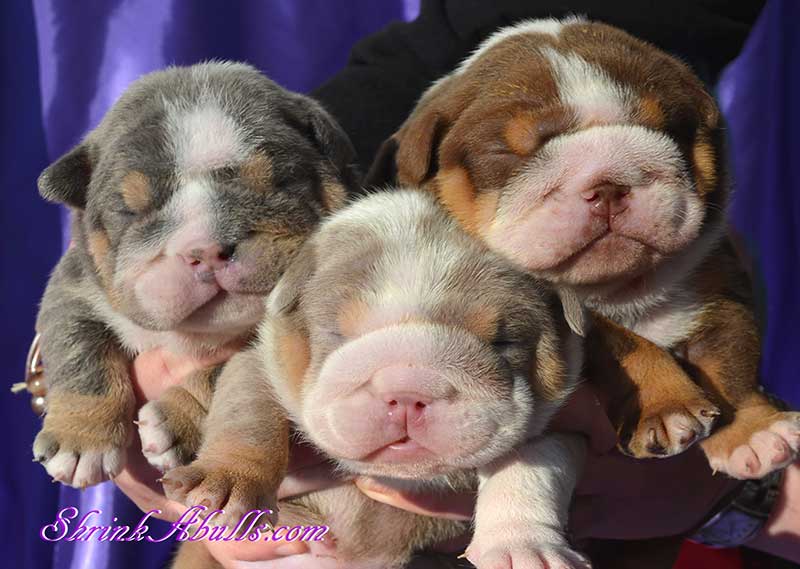 The RARE colors produced in English Bulldogs can be divided into 4 groups (in order of least rare to most rare): BLACK, BLUE, CHOCOLATE, and LILAC. A description of each color, as well as the AKC color designation for each group, is listed below. Genotype: [Kb] and/or [atat] 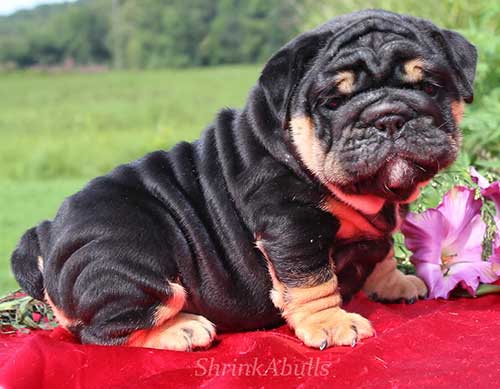 Black Bulldogs are the most common of the rare colors. The black should be shiny and look black even when contrasted against black objects or in the sun (except Seal color, as explained here). May or may not have a fawn undercoat when the hair is rubbed backwards. The nose, eyeliner, and pads are true black.
Black Tri – black and white in any design with tan Points; black and white in any design with tan points
AKC Code: 019-008 (Black & White/Fawn Markings)
Black Bi Seal – black Seal and white in any design; black seal and white in any design
AKC Code: 019 (Black & White)
Black and Tan – black with tan points: a small patch of white on chest only is acceptable; black with tan points: a small patch of white on chest only is acceptable.
AKC Code: 007-008 (Black/Fawn Markings)
Black Brindle and White – black brindle and white in any pattern. Some may show tan points; black brindle and white in any pattern. Some may show tan points.
AKC Code: 059-002 (Brindle & White/Black Markings)
Black Merle/
AKC Code: 019 (Black & White) Black Merle Tri-Black Merle Tri
AKC Code: 019-008 (Black & White/Fawn Markings) Genotype:[dd] 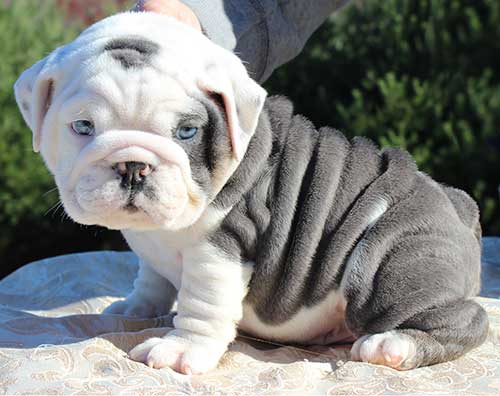 A Blue Bulldog is simply a black dog that has been diluted in color. The blue should be shiny and look gray when contrasted against black objects or in the sun (except seal color, as explained here). May or may not have a fawn undercoat when hair is rubbed backwards. The nose, eyeliner, and pads are slate gray. In the case of the blue fawn, although the hair is not diluted by the [dd] gene, the pigment in the nose, pads and eyeliner is diluted to slate gray. Blue Tri – Blue and white in any design with tan points; blue and white in any design with tan points.
AKC Code: 105-008 (Gray & White/Fawn Markings)
Blue Bi Seal – Blue and white in any design; blue and white in any design.
AKC Code: 105 (Gray & White)
Blue and Tan
AKC Code: 100-008 (Gray/Fawn Markings)
Blue Platinum – All white with no or minimal (less than 10%) body color, usually in spots on face and tail; all white with no or minimal (less than 10%) body color, usually in spots on face and tail.
AKC Code: 105 (Gray & White)
Blue Brindle
AKC Code: 107-014 (Gray Brindle/Fawn Markings)
Blue Merle
AKC Code: 105 (Gray & White)
Blue Merle Tri
AKC Code: 105-008 (Gray & White/Fawn Markings) Genotype:[bb] 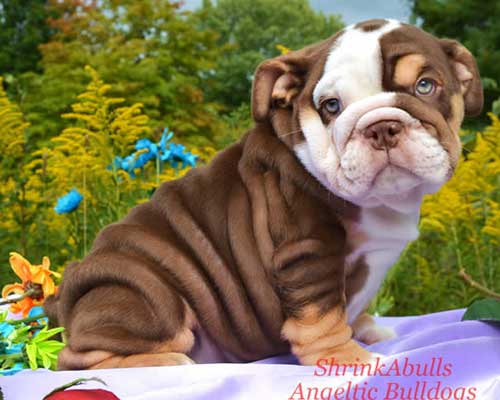 A Chocolate Bulldog is simply a black dog that has been diluted in color. The chocolate should be shiny and look brown when contrasted against black objects or in the sun (except seal color, as explained here). May or may not have a fawn undercoat when hair is rubbed backwards. The nose, eyeliner, and pads are brown/liver. In the case of the Chocolate Fawn, although the hair is not diluted by the [bb] gene, the pigment in the nose, pads and eyeliner is diluted to brown/liver. May or may not have a fawn undercoat when hair is rubbed backwards. The nose, eyeliner, and pads are brown/liver. In the case of the Chocolate Fawn, although the hair is not diluted by the [bb] gene, the pigment in the nose, pads and eyeliner is diluted to brown/liver.
Chocolate Tri – Chocolate and white in any design with tan points; chocolate and white in any design with tan points.
AKC Code: 060-008
(Bronze/Fawn Markings)
Chocolate Bi Seal – Chocolate, seal and white in any design; chocolate, seal and white in any design.
AKC Code: 060-014 (Bronze/White Markings)
Chocolate and Tan – Chocolate with tan points. Small patch of white on chest only is acceptable; chocolate with tan points. Small patch of white on chest only is acceptable.
AKC Code: 060-008 (Bronze/Fawn Markings)
Chocolate Platinumm – All white with no or minimal (less than 10%) body color, usually in spots on face and tail; all white with no or minimal (less than 10%) body color, usually in spots on face and tail.
AKC Code: 060-014 (Bronze/White Markings)
Chocolate Brindle
AKC Code: 060-007 (Bronze/Brindle Markings)
Chocolate Merle
AKC Code: 060-014 (Bronze/White Markings)
Chocolate Merle Tri
AKC Code: 060-008 (Bronze/Fawn Markings)
Genotype:[bb dd] 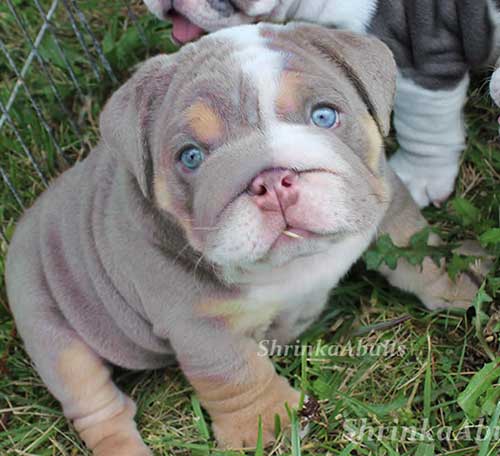 A Chocolate Bulldog is simply a black dog that has been diluted in color, twice ([bb] dilutes black to brown, and [dd] dilutes black to blue]). For example, if you mix blue and brown paint, the end result is some shade of purple or lilac. The lilac should be shiny and look weimaraner gray (or a similar shade of purple/lilac) when contrasted against black objects or in the sun (except Seal color, as explained here). May or may not have a fawn undercoat when hair is rubbed backwards. The nose, eyeliner, and pads are some shade of purple. In the case of the Lilac Fawn, although the hair is not diluted by the [bb, dd] genes, the pigment in the nose, pads and eyeliner is diluted to a purple which varies in shade. Lilac Tri – Lilac and white in any design with tan points; lilac and white in any design with tan points.
AKC Code: 105-008 (Gray & White/Fawn Markings)
Lilac Bi Seal – Lilac and white in any design; lilac and white in any design.
AKC Code: 105 (Gray & White)
Lilac Platinum – All white with no or minimal (less than 10%) body color, usually in spots on face and tail; all white with no or minimal (less than 10%) body color, usually in spots on face and tail.
AKC Code: 105 (Gray & White)
Lilac and Tan
AKC Code: 100-008 (Gray/Fawn Markings)
Lilac Brindle – Lilac brindle and white in any design; lilac brindle and white in any design.
AKC Code: 107-014 (Gray Brindle/White Markings)
Lilac Merle
AKC Code: 105 (Gray & White)
Lilac Merle Tri
AKC Code: 105-008 (Gray & White/Fawn Markings) RARE COLORS: ADDITIONAL INFORMATION Tan Points: As in all tri colors, tan points are typically found on the eyebrows, cheeks, front shoulders (directly above the chest area between the front legs), around the tail, and on both front and back legs. It is normal for the tan points to be absent in these areas if colored white, which simply indicates a lack of pigment). As in all tri colors, tan points are typically found on the eyebrows, cheeks, front shoulders (directly above the chest area between the front legs), around the tail, and on both front and back legs. It is normal for the tan points to be absent in these areas if colored white, which simply indicates a lack of pigment). Platinum: Platinum is basically an all-white dog. It has been acceptable for several years now that dogs with spots of color that total 10% or less of total body color may be designated a Platinum. The preferred “True Platinum” has an all-white coat. Platinum is basically an all-white dog. It has been acceptable for several years now that dogs with spots of color that total 10% or less of total body color may be designated a Platinum. The preferred “True Platinum” has an all-white coat. Fawn Colors vs. True Colors: In Red/Yellow (or Fawn) dogs, the only areas affected by the [bb & dd] gene are the nose, eyeliner, and pad pigments. Therefore, you have a dog with their TRUE, ORIGINAL hair color and then diluted pigment in the aforementioned areas. These dogs should be correctly referred to as Blue Fawn, Chocolate Fawn, and Lilac Fawn no matter what shade fawn they are. NOTE: for any dog to be TRUE color (whether that be Blue, Chocolate, or Lilac), the dog must have a Black base. In Red/Yellow (or Fawn) dogs, the only areas affected by the [bb & dd] gene are the nose, eyeliner, and pad pigments. Therefore, you have a dog with their TRUE, ORIGINAL hair color and then diluted pigment in the aforementioned areas. These dogs should be correctly referred to as Blue Fawn, Chocolate Fawn, and Lilac Fawn no matter what shade fawn they are. NOTE: for any dog to be TRUE color (whether that be Blue, Chocolate, or Lilac), the dog must have a Black base. Brindle/Trindle: Brindle is a brownish/tawny color of fur, whereas a Trindle has the Brindle only in the tan points. Technically, a Trindle is a full brindle dog, except that that the brindle only shows up on areas that are tan. Brindle is a brownish/tawny color of fur, whereas a Trindle has the Brindle only in the tan points. Technically, a Trindle is a full brindle dog, except that that the brindle only shows up on areas that are tan. Seal: Dogs shine seal through a different color (usually red, but can be fawn, gray, or even green shades), from under the coat, especially in the sun. They are almost always 2 colors (the second being white).Dogs shine seal through a different color (usually red, but can be fawn, gray, or even green shades), from under the coat, especially in the sun. They are almost always 2 colors (the second being white). Merle: Merle dilutes random sections of hair to a lighter color, leaving patches of the original color. The patches may look jagged on the outer edges. When a dog has black, blue, chocolate, or lilac in his or her coat, the coat, eyes, or nose will be merled.Merle dilutes random sections of hair to a lighter color, leaving patches of the original color. The patches may look jagged on the outer edges. When a dog has black, blue, chocolate, or lilac in his or her coat, the coat, eyes, or nose will be merled. 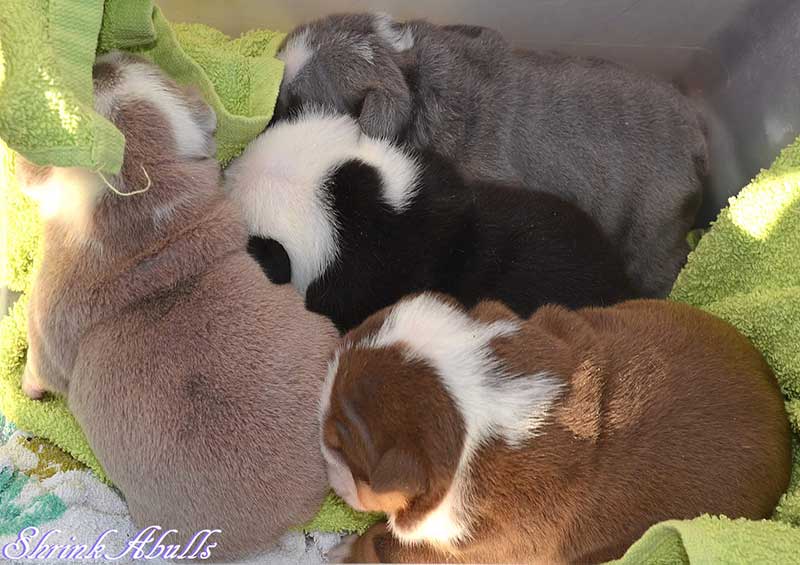 PLEASE CONTACT:
***SHRINKABULL MINI BULLDOGS*** SHRINKABULL ENGLISH BULLDOGS & MINIATURE ENGLISH can arrange safe VIP flights for your new Mini Bulldog puppy to new homes in: Alabama, AL; Alaska, AK; Arizona, AZ; Arkansas, AR; California , CA; Colorado, CO; Connecticut, CT; Delaware, DE; Florida, FL; Georgia, GA; Hawaii, HI; Idaho, ID; Illinois, IL; Indiana, IN; Iowa, IA; Kansas, KS; Kentucky, KY; Louisiana, LA; Maine, ME; Maryland, MD; Massachusetts, MA; Michigan, MI; Minnesota, MN; Mississippi, MS; Missouri, MO; Montana, MT; Nebraska, NE; Nevada, NV; New Hampshire, NH; New Jersey, NJ; New Mexico, NM; New York, NY; North Carolina, NC; North Dakota, ND; Ohio, OH; Oklahoma, OK; Oregon, OR; Pennsylvania, PA; Rhode Island, RI; South Carolina, SC; South Dakota, SD; Tennessee, TN; Texas, TX; Utah, UT; Vermont, VT; Virginia , VA; Washington, WA; West Virginia, WV; Wisconsin, WI; Wyoming, WY, Canada and we can ship Mini Bulldog puppies to approved homes that are out of country depending on quarantine laws & other conditions… |
Privacy Policy
Content and pictures found on this website Copyright © 2002– 2022 SHRINKABULLS


 REVIEWS
REVIEWS